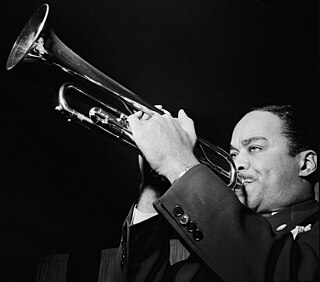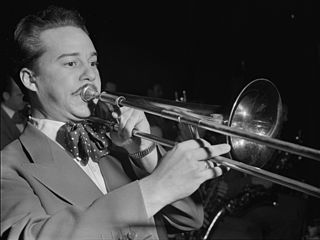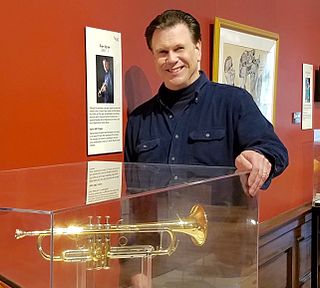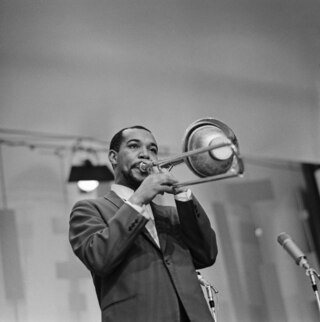Related Research Articles

William James "Count" Basie was an American jazz pianist, organist, bandleader, and composer. In 1935, he formed the Count Basie Orchestra, and in 1936 took them to Chicago for a long engagement and their first recording. He led the group for almost 50 years, creating innovations like the use of two "split" tenor saxophones, emphasizing the rhythm section, riffing with a big band, using arrangers to broaden their sound, his minimalist piano style, and others.

Frank Wellington Wess was an American jazz saxophonist and flutist. In addition to his extensive solo work, Wess is remembered for his time in Count Basie's band from the early 1950s into the 1960s. Critic Scott Yanow described him as one of the premier proteges of Lester Young, and a leading jazz flutist of his era—using the latter instrument to bring new colors to Basie's music.

Harry "Sweets" Edison was an American jazz trumpeter and a member of the Count Basie Orchestra. His most important contribution was as a Hollywood studio musician, whose muted trumpet can be heard backing singers, most notably Frank Sinatra.

Louie Bellson, often seen in sources as Louis Bellson, although he himself preferred the spelling Louie, was an American jazz drummer. He was a composer, arranger, bandleader, and jazz educator, and is credited with pioneering the use of two bass drums.

Thaddeus Joseph Jones was an American jazz trumpeter, composer and bandleader who has been called "one of the all-time greatest jazz trumpet soloists".

Wilbur Dorsey "Buck" Clayton was an American jazz trumpeter who was a member of Count Basie's orchestra. His principal influence was Louis Armstrong, first hearing the record "Confessin' that I Love You" as he passed by a shop window.

Al Grey was an American jazz trombonist who was a member of the Count Basie orchestra. He was known for his plunger mute technique and wrote an instructional book in 1987 called Plunger Techniques.

The Count Basie Orchestra is a 16- to 18-piece big band, one of the most prominent jazz performing groups of the swing era, founded by Count Basie in 1935 and recording regularly from 1936. Despite a brief disbandment at the beginning of the 1950s, the band survived long past the big band era itself and the death of Basie in 1984. It continues under the direction of trumpeter Scotty Barnhart.
Joseph Dwight Newman was an American jazz trumpeter, composer, and educator, best known as a musician who worked with Count Basie during two periods.

Frank Benjamin Foster III was an American tenor and soprano saxophonist, flautist, arranger, and composer. Foster collaborated frequently with Count Basie and worked as a bandleader from the early 1950s. In 1998, Howard University awarded Frank Foster with the Benny Golson Jazz Master Award.

Grover Mitchell, born Grover Curry Mitchell was an American jazz trombonist who led the Count Basie Orchestra.
William Melvin Mitchell was an American jazz tenor saxophonist.

Nathaniel Pierce Blish Jr., known professionally as Nat Pierce was an American jazz pianist and prolific composer and arranger, perhaps best known for being pianist and arranger for the Woody Herman band from 1951 to 1955. Pieces by Pierce were predominantly created for use in big bands.

Edward Joseph Bertolatus, also known as Eddie Bert, was an American jazz trombonist.
Matthew Gee was an American bebop trombonist.
Henry Coker was an American jazz trombonist.

Roger O'Neal Ingram is a jazz trumpeter, educator, author, and instrument designer. He played trumpet for the orchestras of Maynard Ferguson, Woody Herman, Wynton Marsalis, Ray Charles, and Harry Connick Jr.

Benny Powell was an American jazz trombonist. He played both standard (tenor) trombone and bass trombone.

Dennis Mackrel is an American jazz drummer, composer, and arranger who was a member of the Count Basie Orchestra and the Vanguard Jazz Orchestra.
Byron Stripling is a jazz trumpeter who has been a member of the Count Basie Orchestra.